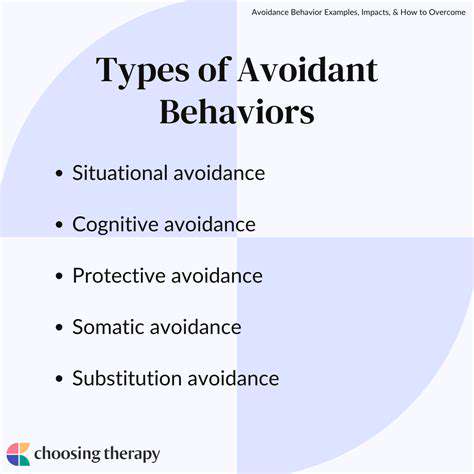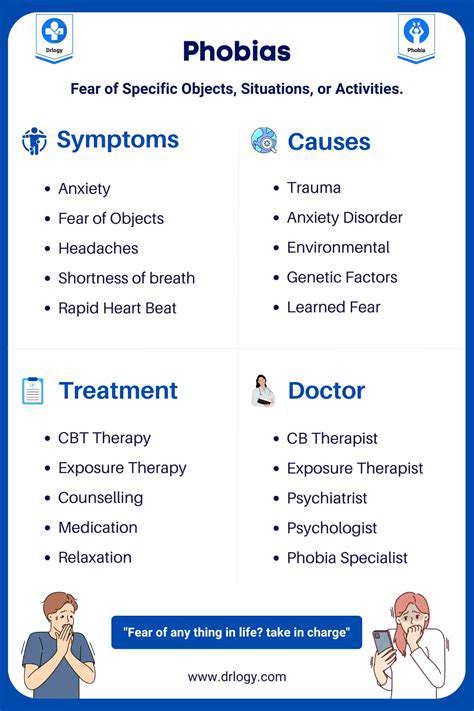Recognizing Phobia Symptoms: A Comprehensive Overview
When we talk about specific phobias, we're referring to a distinct group of anxiety disorders where individuals experience overwhelming fear toward particular objects, activities, or scenarios. What makes these phobias particularly challenging is that the fear response often bears no rational relation to the actual risk involved. Take acrophobia (fear of heights) or claustrophobia (fear of enclosed spaces) as examples - these fears can completely disrupt a person's ability to function normally in everyday situations that others take for granted.
The physical manifestations of these phobias can be quite dramatic. Imagine your heart suddenly racing, palms sweating uncontrollably, and breath coming in short gasps - all because you spotted a harmless spider or needed to ride an elevator. These visceral reactions occur instantly, demonstrating how deeply phobias can affect both mind and body.
Social Anxiety Disorder: Fear of Social Situations
Social phobia goes beyond simple shyness. It's characterized by paralyzing dread at the thought of social interactions, stemming from intense fear of negative evaluation. For those affected, everyday activities like eating in public or making small talk can feel like insurmountable challenges. This condition often leads to social isolation, which ironically reinforces the very fears the person is trying to avoid.
Agoraphobia: Fear of Open Spaces and Crowds
Agoraphobia creates a cruel paradox - sufferers fear situations where they might experience panic, yet the fear itself can trigger panic attacks. This condition often develops after someone has experienced panic attacks in public places, creating an association between open spaces and overwhelming anxiety. The resulting avoidance behaviors can become so severe that individuals may become essentially housebound, unable to perform basic tasks like grocery shopping.
Panic Disorder: Recurrent Panic Attacks
Panic disorder involves sudden, unpredictable episodes of intense terror accompanied by physical symptoms so severe they're often mistaken for heart attacks. The hallmark of this condition isn't just the attacks themselves, but the persistent fear of when the next one might strike. This anticipatory anxiety can be just as debilitating as the actual panic episodes.
Generalized Anxiety Disorder: Persistent Worry
GAD transforms normal concerns into constant, exhausting mental turmoil. Unlike specific phobias that focus on particular triggers, GAD spreads like ink in water, coloring every aspect of life with apprehension. The worrying becomes self-perpetuating - the more one worries, the harder it becomes to stop. Physical symptoms like muscle tension and fatigue often accompany the psychological distress.
Specific Phobia Triggers: Understanding the Causes
The origins of phobias are as varied as the phobias themselves. Some develop after traumatic incidents, while others seem to emerge without obvious cause. Interestingly, research suggests we may be evolutionarily predisposed to fear certain things like snakes or heights more easily than modern dangers like cars or electrical outlets. Understanding these roots can be crucial for effective treatment.
Treatment Approaches for Phobias: Exploring Options
Modern psychology offers several evidence-based approaches to phobia treatment. Cognitive-behavioral techniques help rewire thought patterns, while exposure therapy gradually desensitizes individuals to feared stimuli. What's most encouraging is that these treatments often yield significant improvements, sometimes in relatively short timeframes. Medication can play a supporting role, particularly for managing acute symptoms during the therapeutic process.
Behavioral Responses and Avoidance Behaviors

Understanding Behavioral Responses
Our automatic reactions to perceived threats represent complex interplay between instinct and learned behavior. These responses, while often helpful in genuine danger, can become maladaptive when triggered inappropriately by phobic stimuli. The brain doesn't distinguish well between real and imagined threats when activating these primal defense mechanisms.
Types of Avoidance Behaviors
Avoidance takes many forms, from obvious physical evasion to subtle mental distraction techniques. The common thread is that all avoidance strategies provide temporary relief at the cost of long-term maintenance of the problem. Even productive avoidance like excessive cleaning or workaholism can mask underlying anxiety issues.
The Role of Anxiety in Avoidance
Anxiety and avoidance exist in a self-perpetuating cycle. Each successful avoidance temporarily reduces anxiety, reinforcing the behavior. This reinforcement makes the avoidance increasingly automatic and harder to resist over time. Breaking this cycle requires confronting the anxiety rather than fleeing from it.
Impact on Mental Well-being
The psychological toll of chronic avoidance extends far beyond the original anxiety. Persistent avoidance can lead to what psychologists call secondary depression - feelings of hopelessness that develop when one's life becomes increasingly constrained by fear. Relationships suffer, opportunities are missed, and self-esteem erodes.
Cognitive Biases and Avoidance
Our minds play tricks on us when anxiety takes hold. We overestimate dangers, underestimate our coping abilities, and imagine worst-case scenarios as inevitable. These distorted thought patterns aren't character flaws - they're predictable products of how the anxious brain processes information. Recognizing them is the first step toward regaining perspective.
Strategies for Addressing Avoidance
Effective intervention requires a graduated approach. Small, manageable challenges build confidence and provide evidence that contradicts catastrophic expectations. Mindfulness techniques help develop tolerance for discomfort, while cognitive restructuring challenges irrational beliefs that fuel avoidance.
Long-Term Implications of Avoidance
The cumulative effect of avoidance is a life that becomes progressively smaller. Each avoided situation makes the next one seem more daunting, creating a downward spiral of increasing limitation. Conversely, each successfully faced challenge makes subsequent ones easier, creating upward momentum toward greater freedom and fulfillment.
